The Electronic Intifada 3 April 2014
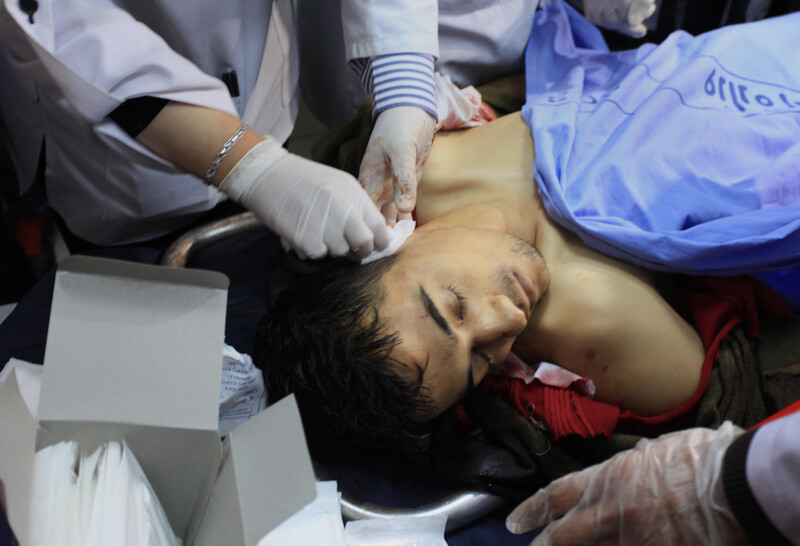
Palestinian medics at a hospital in the West Bank City of Ramallah attempt to save the life of Saji Darwish, a Palestinian university student who was shot by Israeli forces on 10 March. Darwish soon died of his wounds.
APA imagesYarmouk and Sbeineh refugee camps in Syria remained sealed and malnutrition widespread, contributing to a rising number of Palestinian refugee deaths, the United Nations reported in March.
Access to the camps was blocked by security forces, according the UN, which added that “less than 30 percent of Yarmouk residents remain and less than 5 percent in Sbeineh, with armed opposition elements present in both.”
The pre-war populations in the Damascus-area camps of Yarmouk and Sbeineh were nearly 150,000 and approximately 22,600 residents, respectively, according to UN figures.
At the time of publication, the Syrian authorities had suspended UNRWA, the UN agency for Palestine refugees, from access to Yarmouk camp, the agency reported.
UNRWA added that the average daily distribution rate was only 97 food parcels per day in Yarmouk camp, where approximately 18,000 civilians remain trapped.
Approximately half of the 500,000 registered Palestinian refugees in Syria remain displaced, with more than 50,000 Palestinian refugees from Syria currently in Lebanon, half of whom are residing in the country’s already overcrowded camps which lack health, water and sewage infrastructure and management.
Meanwhile in the occupied West Bank, the number of Palestinians killed by Israeli forces since the beginning of the year rose to nine this month.
Fourteen-year-old Yussef Shawamreh was shot while foraging for edible plants near Israel’s wall in al-Ramadin village near Hebron on 19 March. On 22 March Hamza Abu al-Haija was shot and killed after an exchange of fire during a late-night arrest raid in Jenin refugee camp. Two other men were shot and killed at the same site while reportedly attempting to recover Abu al-Haija’s body.
Two Palestinian civilians were killed by Israeli forces in separate incidents on 10 March; Raed Zuaiter, a 38-year-old Jordanian judge of Palestinian origin, was shot at Allenby crossing between Jordan and the occupied West Bank and 20-year-old university student Saji Darwish from Beitin village died after he was shot in the head.
In the occupied Gaza Strip, Israeli forces shot and killed three members of a Palestinian armed group during an incursion on 11 March and two suspected members of an armed group were killed in an Israeli air strike on 3 March which also injured a woman and child, according to UN reportage.
A 52-year-old Palestinian woman in northern Gaza was killed on 12 March when a rocket fired from Gaza aimed at Israel fell short.
The Egyptian authorities prevented thousands of Palestinians from leaving Gaza via the Rafah crossing, the sole entry and exit point for the vast majority of Gaza’s 1.6 million residents, allowing passage only to pilgrims since early February.
Severe shortages of fuel as a result of Israel’s years-long blockade has resulted in Gaza’s power plant operating at only half of its capacity, “triggering an average of rolling power outages of up to 12 hours per day,” according to the UN, which adds, “On several occasions, it has been forced to shut down completely, resulting in scheduled blackouts of up to 16 hours a day.”
The power cuts mean that “more than 30 percent of households in Gaza are supplied with running water for six to eight hours only once every four days,” tens of millions of liters of partially treated sewage are discharged into the Mediterranean Sea every day, and the average waiting time for some types of elective surgery at Gaza’s largest hospital is more than a year.

Protesters call for the cancelation of the 1994 Israel-Jordan Wadi Araba peace treaty during a demonstration outside the Jordanian parliament in Amman on 18 March. Protests erupted following the killing of Raed Zuaiter, a Jordanian judge of Palestinian descent, by Israeli soldiers at Allenby crossing between Jordan and the occupied West Bank the previous week. Jordan’s prime minister Abdullah Ensour escaped a no-confidence vote by parliament that was motivated by what critics say was his government’s weak response to the killing of Zuaiter.
AFP/Getty Images
Relatives of 14-year-old Yussef Shawamreh mourn outside his house in the West Bank village of Deir al-Asal, 15 kilometres from Hebron, on 19 March after the Palestinian boy was killed by Israeli troops. Witnesses said the victim had been foraging for plants with two friends when he was shot.
APA images
Palestinians carry a coffin containing the body of Palestinian fighter Muhammad Hanbali, who was killed by Israeli forces 11 years ago, during his funeral in the West Bank city of Nablus, 19 March. Since the late 1960s, Israel has withheld the bodies of hundreds of Palestinians. Their bodies are interred in numbered graves in four cemeteries created for that purpose, the biggest of which is located in the occupied West Bank’s Jordan Valley.
APA images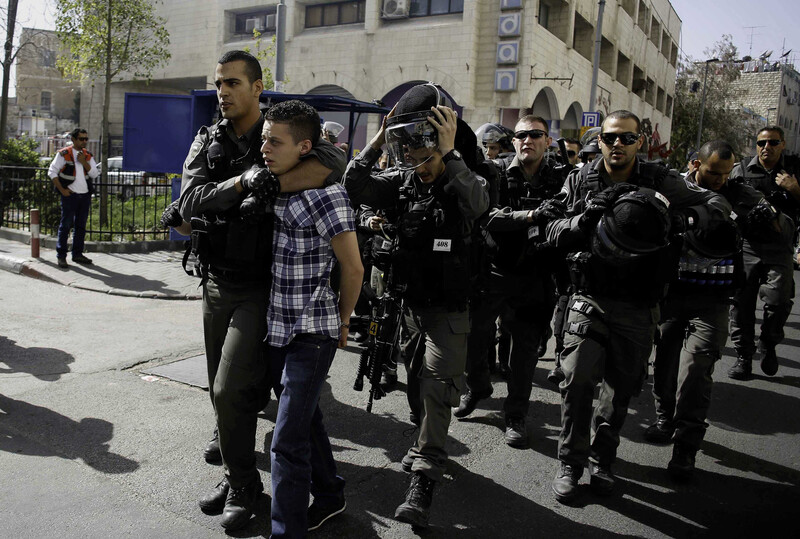
A Palestinian is arrested by Israeli forces in the Old City of Jerusalem during clashes following a rally marking Land Day, 29 March. The annual demonstrations mark the deaths of six Palestinian citizens at the hands of Israeli police and troops during mass protests on 30 March 1976 against plans to confiscate Arab land in the northern Galilee.
APA images
An Israeli border police officer confronts a Palestinian protester during a Land Day demonstration at the Old City of Jerusalem’s Damascus Gate, 30 March.
ActiveStills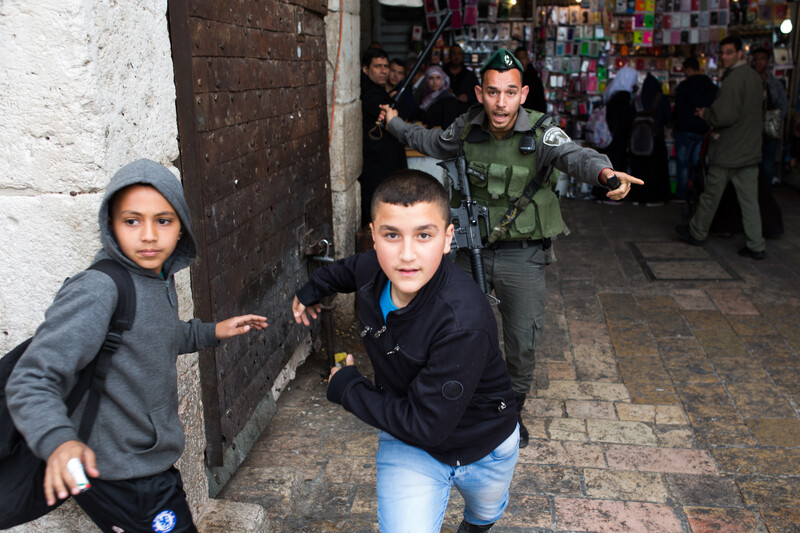
An Israeli border police officer chases Palestinian children during a Land Day demonstration at the Old City of Jerusalem’s Damascus Gate, 30 March.
ActiveStills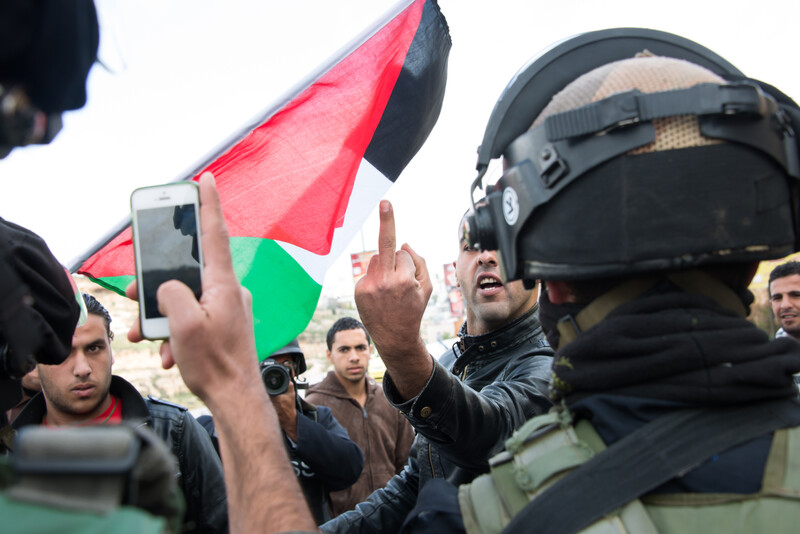
Palestinian activists confront Israeli soldiers during a Land Day demonstration in the West Bank village of al-Khader, 30 March.
ActiveStills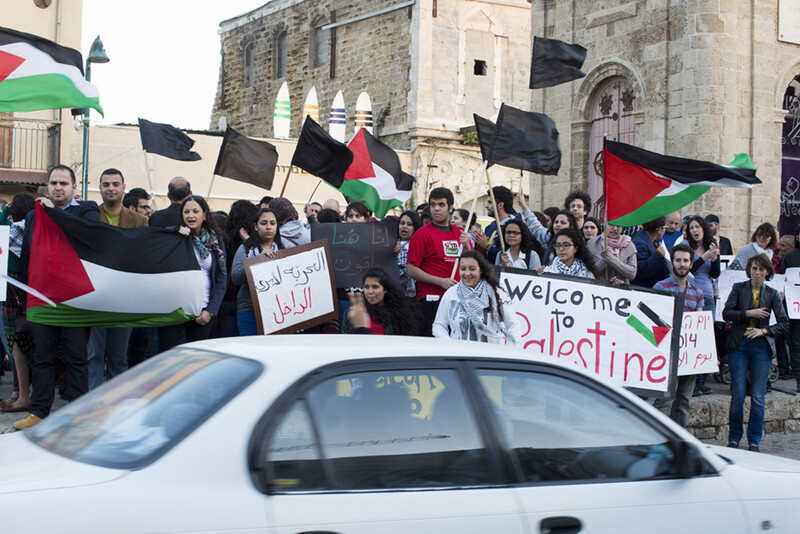
Palestinians in Jaffa commemorate Land Day, 30 March.
ActiveStills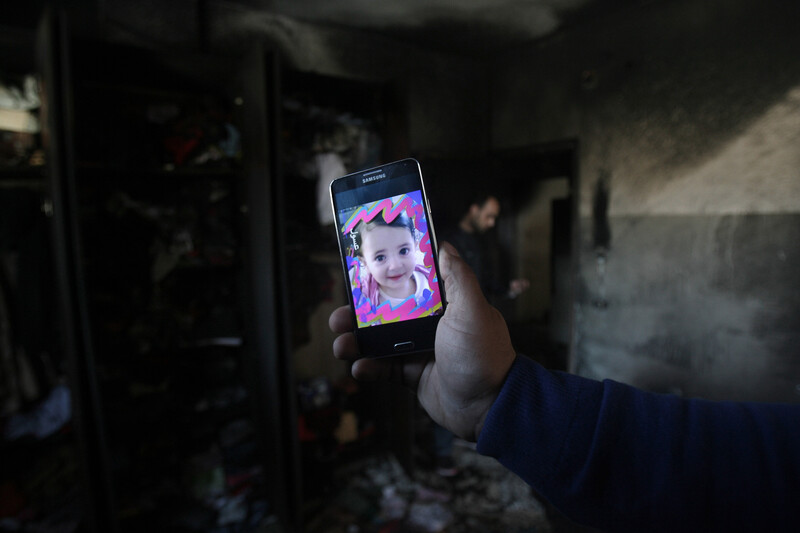
A Palestinian man displays a picture of Ghena el-Eid who was killed after a fire swept through her room in the southern Gaza Strip city of Rafah on 27 March. Gaza residents often use candles to light their homes during frequent power cuts resulting from the Israeli-Egyptian blockade, which can last up to eight hours a day.
APA images
A Palestinian officer stands guard outside the Egyptian representative office in Gaza City during a demonstration against Egypt’s banning of Hamas, 7 March. An Egyptian court banned all Hamas activities in the latest move to squeeze the Palestinian Islamist group.
APA images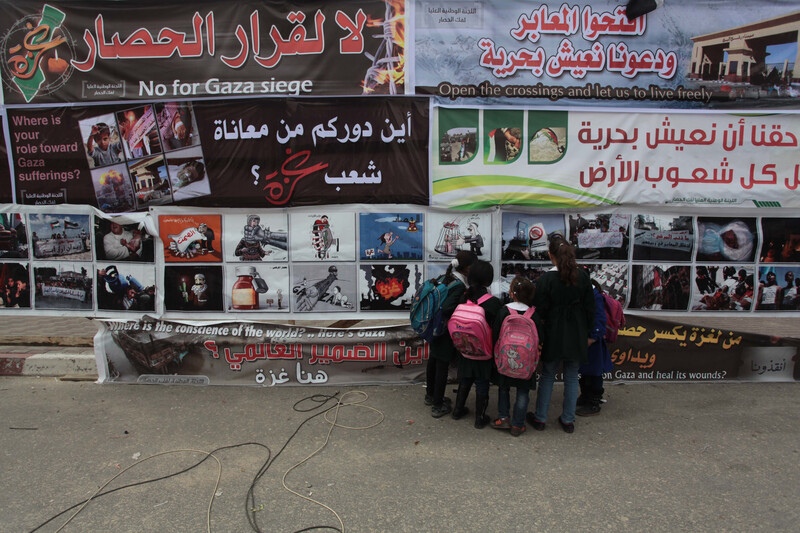
Palestinian girls examine a banner depicting the victims of blockade during a protest against the Israeli-Egyptian siege in Gaza City, 17 March.
APA images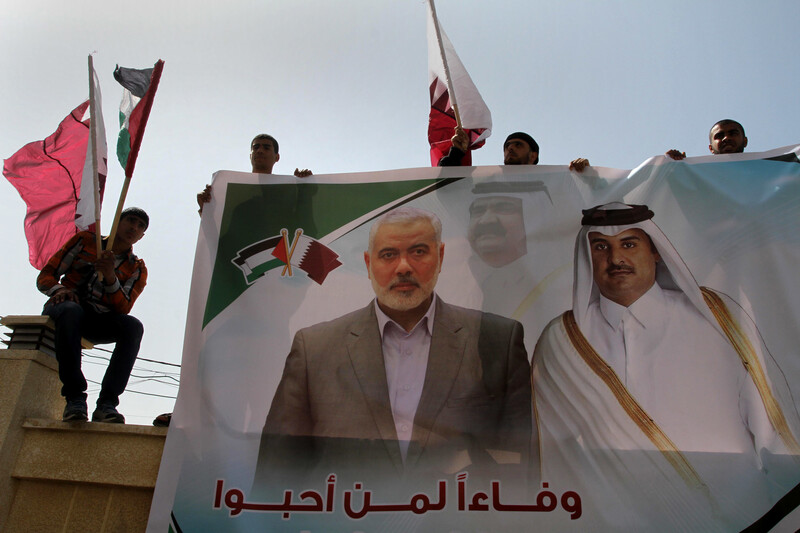
Palestinians hold pictures of Ismail Haniyeh, de facto Prime Minister in the Gaza Strip, and Sheikh Tamim bin Hamad Al Thani, Emir of Qatar, during a rally in Gaza City on 19 March. The Emir of Qatar pledged his country’s continued assistance to Gaza earlier that week during a meeting with Haniyeh. Qatar had previously supplied the Gaza Strip with fuel after the territory’s power plant shut down for lack of fuel as a result of the siege.
APA images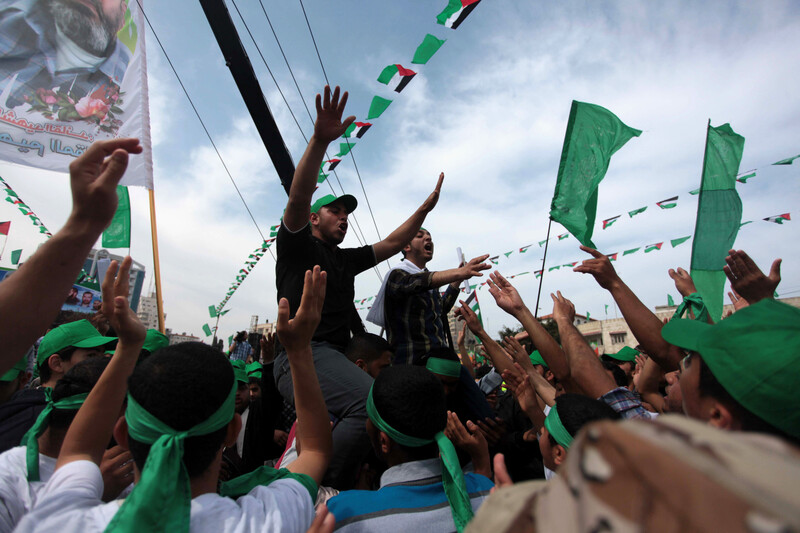
Palestinians in Gaza City wave Hamas flags before the start of a rally marking the anniversary of Israel’s assassination of the party’s elderly spiritual leader Ahmad Yassin, 23 March.
APA images
Palestinian riot police demonstrate their skills during a training session with European Union police forces in the West Bank city of Ramallah, 16 March.
APA images
US President Barack Obama and members of his administration meet with Palestinian Authority leader Mahmoud Abbas in Washington, DC, on 17 March ahead of an end of April deadline for determining a framework for the faltering Israeli-Palestinian negotiations.
APA images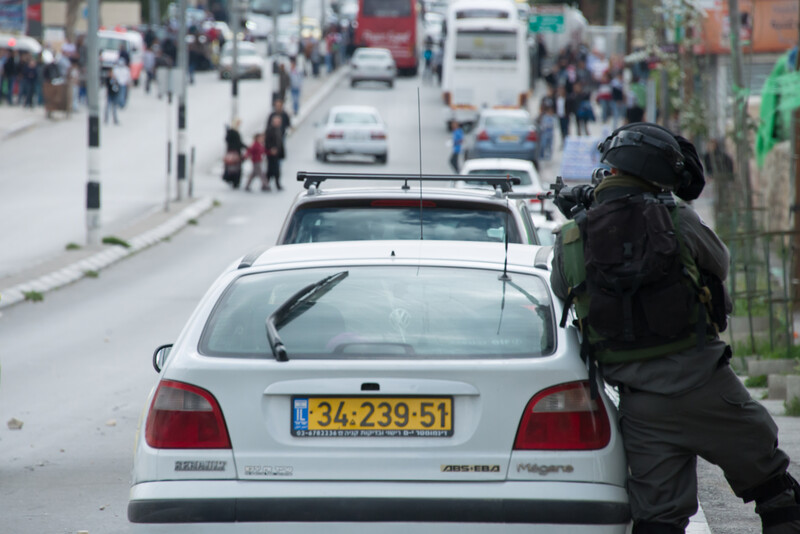
An Israeli soldier prepares to fire rubber-coated steel bullets at stone-throwing Palestinian youth during clashes in the West Bank town of Bethlehem, 11 March. The clashes erupted after Israeli forces killed six Palestinians in the West Bank and Gaza in the previous 24 hours.
ActiveStills
A Palestinian boy sits on the rubble of his home after it was destroyed by Israeli forces in Khallat al-Ein square in the al-Tur neighborhood east of Jersualem’s Old City, 26 March. Israel rarely grants Palestinian Jerusalemites permits to build and has demolished at least 27,000 Palestinian homes and structures since occupying the West Bank in 1967, according to the Israeli Committee Against House Demolitions.
APA images
Hebrew-language graffiti reading “Gentiles in the land are enemies” is scrawled on a Palestinian bus in the East Jerusalem neighborhood of Beit Hanina, 24 March.
ActiveStills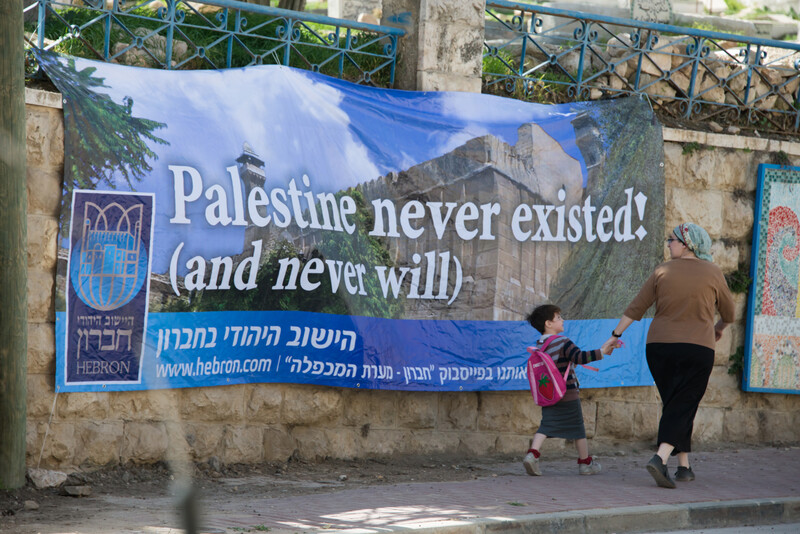
A Jewish settler woman and child walk near a banner reading “Palestine never existed! (and never will)” on Shuhada Street in the West Bank city of Hebron, 7 March. Israel severely restricted Palestinian access to Shuhada Street, previously the main commercial center of Hebron, following a 1994 massacre perpetrated by a settler in the city’s Ibrahimi Mosque.
ActiveStills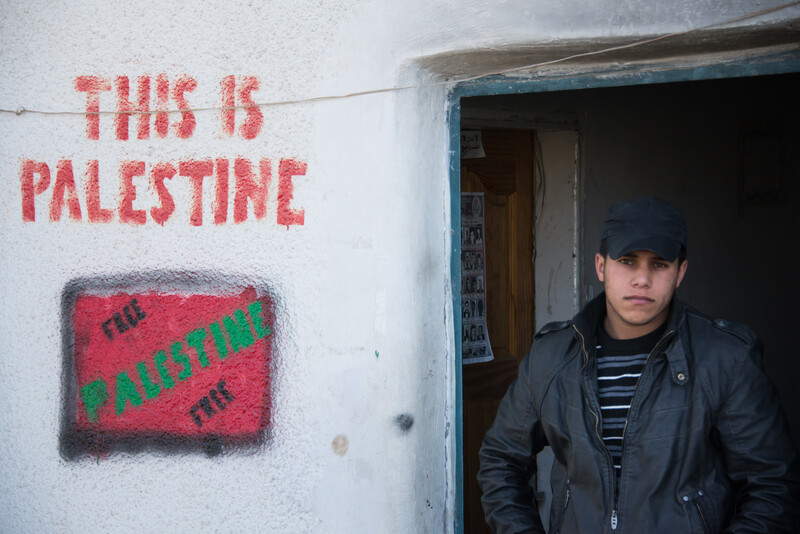
A Palestinian youth stands in the doorway of the headquarters of Youth Against Settlements near the Tel Rumeida settlement in the West Bank city of Hebron, 7 March. Tel Rumeida is home to some of Hebron’s most extremist settlers; Youth Against Settlements is an activist group which seeks to end Israeli colonization in Palestine through nonviolent popular struggle and civil disobedience.

Palestinian women in Gaza City protest against the rising incidents of violence against women, 3 March. Twenty-six women were slain by relatives in the West Bank and Gaza in 2013, twice as many as the year before, according to official figures.
APA images
Palestinian women take part in a protest outside the Gaza City headquarters of UNRWA, the UN agency for Palestine refugees, against reported reductions to food aid to the Gaza Strip, 5 March.
APA images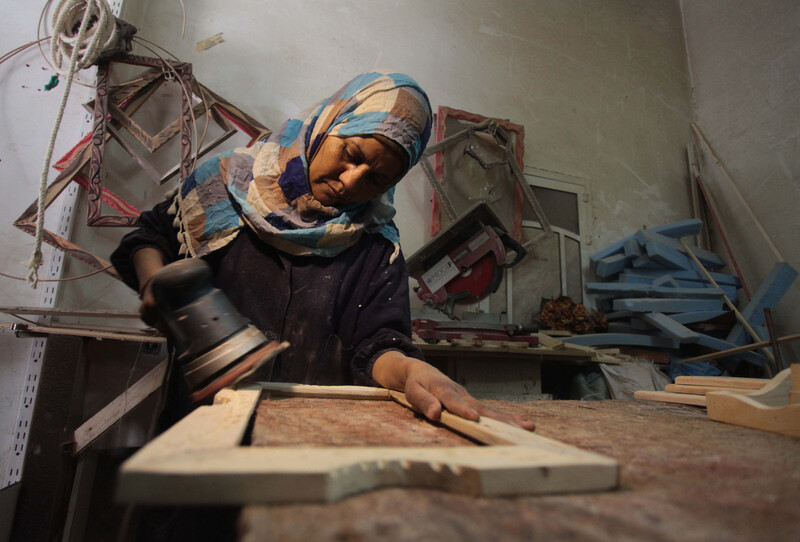
Amal Abu-Rqayiq works at her small carpentry workshop in the Nusseirat refugee camp in the Gaza Strip on International Women’s Day, 8 March. Amal is a 40-year-old divorcee working in a male-dominated profession to help raise a daughter with special needs.
APA images
A Palestinian woman takes part in an exhibition of Palestinian heritage on the occasion of Mother’s Day in Jerusalem’s Old City, 18 March.
APA images
Palestinian actors perform during a Gaza City ceremony marking World Civil Defense Day organized by the Interior Ministry in the Gaza Strip, 3 March.
APA images
A young shepherd rides on his donkey back to his flock outside the Bedouin community of Jahalin, a village in the Jerusalem periphery under constant threat of eviction and demolition by Israeli authorities, 2 March.
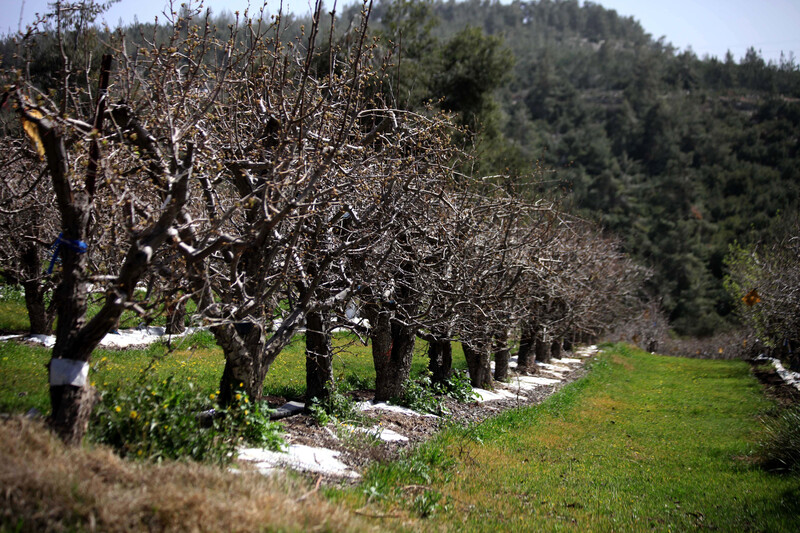
Flowers and trees bloom in the village of Suba, west of Jerusalem, 5 March. Suba was a Palestinian village west of Jerusalem that was depopulated and almost completely destroyed during the 1948 ethnic cleansing of Palestine.
APA images
Palestinian youths pilot a remote-controlled drone plane fitted with a camera during a test run at al-Yarmouk Stadium in Gaza City, 1 March. The Palestinian company Media Town imported a drone plane dedicated to film and media production.
APA images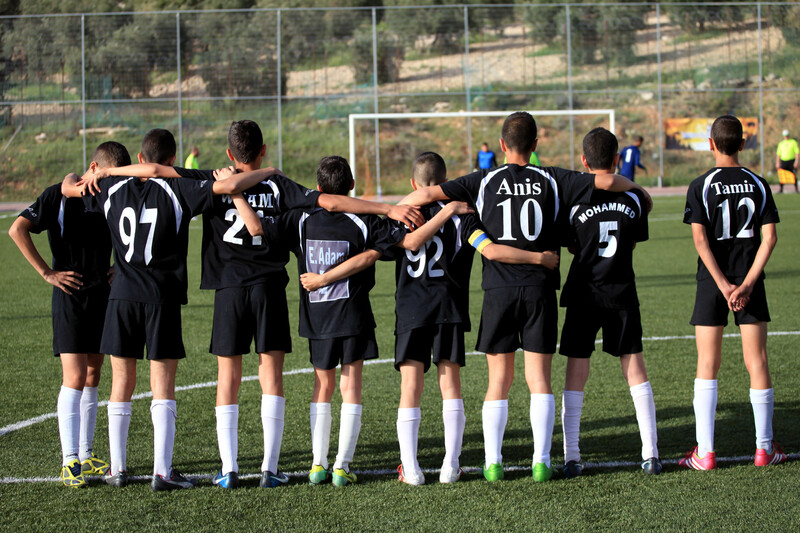
Palestinian athletes gather during a 29 March match with a Jordanian football club in Jerusalem.
APA images

